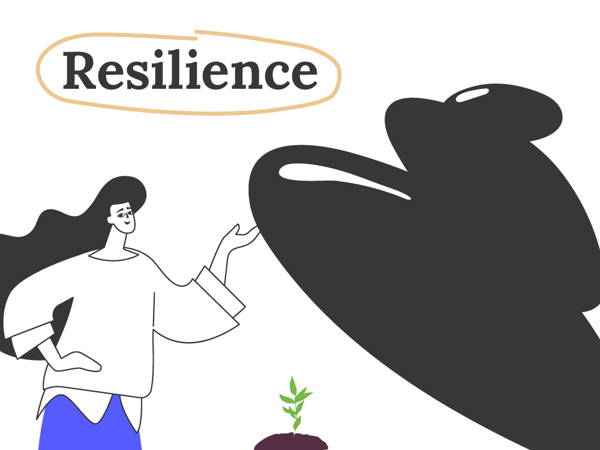Why resilience is a key ingredient in the modern workplace, and how to develop it.

Over the past couple of years, the idea of what a typical workplace looks like has been scrapped and redefined. Whether it’s trying to return to a new “normal” after the pandemic, or picking up the slack of team members who have decided to resign, the stress of the office can often seem overwhelming and constant. It doesn’t have to be that way though.
Here at The Conscious Leadership Company (TCLC for short), one of our goals is to provide leaders with the resources they need to focus on workplace wellbeing while maintaining productivity. We want to help leaders, like yourself, thrive in the modern workplace, instead of simply survive. To do this we have developed a framework based on the five pillars of conscious leadership. One of these pillars is resilience which includes the need to preserve energy, maintain your mindset, and learn to work in a sustainable, conscious way. With workplace stress and burnout on the rise, resilience is an essential ingredient for success in today’s modern working environment.
What is resilience?
To understand the need for resilience better, it is important to know what resilience is and what it isn’t. Despite what some might think, resilience isn’t a synonym for stamina. It isn’t about staying switched on all the time, or constantly going despite the challenges you face or the stress you feel. Resilience isn’t defined by the ability to stay strong, regardless of pressure. Instead, think of resilience as your ability to recover from a setback and stabilize after a difficult workday or week. Think of resilience as your ability to bounce back. There will always be stress and anxiety in your life, especially in your work life, but by strengthening your resilience, you will be better equipped to navigate these challenges when they arise.
Making resilience a priority
While it is clear that maintaining a high level of resilience in the workplace is beneficial, sometimes this is easier said than done and it can be hard to know where to start. Below we have highlighted a few things that will help you make resilience a priority, and will set you on a path to being a more conscious leader.
Learn from your challenges
It is normal to become overwhelmed or stressed out when faced with a difficult task at work. From helping your team reach key targets, to being put in charge of a project you are unfamiliar with, it’s no surprise leaders are increasingly stressed out. Without resilience, this pressure can become a ticking time bomb and lead to a risk of burnout. According to Microsoft’s second annual Worker Trend Index, since the start of the pandemic a staggering 82% of leaders reported feeling exhausted and 41% of employees are considering leaving their jobs.
But what if we changed the way we viewed these workplace stressors? What if we viewed them as challenges that needed to be tackled, and more importantly as challenges that could be tackled? Leaders who are more resilient, and take a conscious approach to their leadership, see these obstacles as opportunities to grow and develop. They are not afraid to analyse what went wrong when a target wasn’t met, or a project didn’t succeed. They bounce back from their mistakes, take the lessons they learned, and use them to tackle challenges in the future.
Address stress and its triggers
While we can reframe the way we view stressful tasks (seeing them as a challenge or an opportunity), there are other elements in the workplace that cause stress and it is just as important to understand what triggers them so they can be dealt with. Whether it is an excessive workload, a lack of support, or a poor work/life balance, without resilience, it is easy to feel consumed and overwhelmed.
To start with, identify the specific triggers that can lead you to feel this way. Reflect back on when you start to feel stressed at work and the reasons behind it. Then most importantly, address these triggers. This could look like you setting boundaries for yourself in the workplace. Make it clear that you are not going to over-extend yourself with too many projects or that you will only respond to work communication during office hours. Whatever the triggers you identify maybe, take proactive steps to address each one. By doing so, you are strengthening your resilience and becoming a more conscious leader.
Focus on your own wellbeing
Now more than ever, leaders are being asked to put the needs of their organisation, and their team ahead of their own. Conscious and resilient leaders recognise how crucial it is to prioritise their own self-care and wellbeing in the workplace. This could look like making sure to exercise regularly, drink plenty of water, or get a good night's sleep.
Conscious leaders listen to their bodies and give themselves permission to take care of their own needs, even if those needs come before their organisation or team. After all, you need to put on your own oxygen mask before you help others with theirs. In reality, focusing on self-care and wellbeing not only help improve resilience, but are also connected to higher levels of productivity, job satisfaction, and reduced levels of burnout.
Rinse and Repeat
Improving resilience and becoming a more conscious leader takes constant effort. It is not something that simply develops overnight. Give yourself permission to make mistakes, to fall down and pick yourself back up again, to prioritise your own wellbeing, and then rinse and repeat.
If you’d like to become more “resilient” and be a better leader, we’ve got the tools to help you. Our University College London (UCL) validated Conscious Leader psychometric gives you a real-time view of how you’re doing as a leader. At the same time, our Consciously app is a digital learning and wellbeing platform that helps you build healthy habits and work in a sustainable way.
 Natasha Wallace
Natasha Wallace


